Upstate New York Trip Part I - Cornell University
(Translated from the Chinese version with the help of Claude.)
Preface
I planned a summer trip, but I had already visited nearby cities like New York City, Boston, Philadelphia, and Washington. Where to go next? Looking at the map, I decided on Niagara Falls near the US-Canada border! Along the way, I could visit Cornell University. After consulting Claude, I also discovered the Women’s Rights National Historical Park in Seneca Falls was on the route. Let’s go!
Cornell University
Years ago, when I applied to US PhD programs, I received some offers and some rejections. I clearly remember Cornell was the last to respond - unfortunately also with a rejection, probably from the waiting list. Fifteen years later, times have changed, and I finally set foot on their campus.
After driving for hours through upstate New York’s rural areas, I arrived in Ithaca1 and finally felt like I was in a proper town. Driving up the hill into campus, I found the university website excellent, with comprehensive parking information and official campus tour guide.
Founding History
Following the official tour guide, I first visited the Martin Y. Tang Welcome Center (probably built with donations from a prominent Chinese-American alumnus). Inside was a small exhibition briefly introducing the history since the university’s founding and its distinguished alumni.
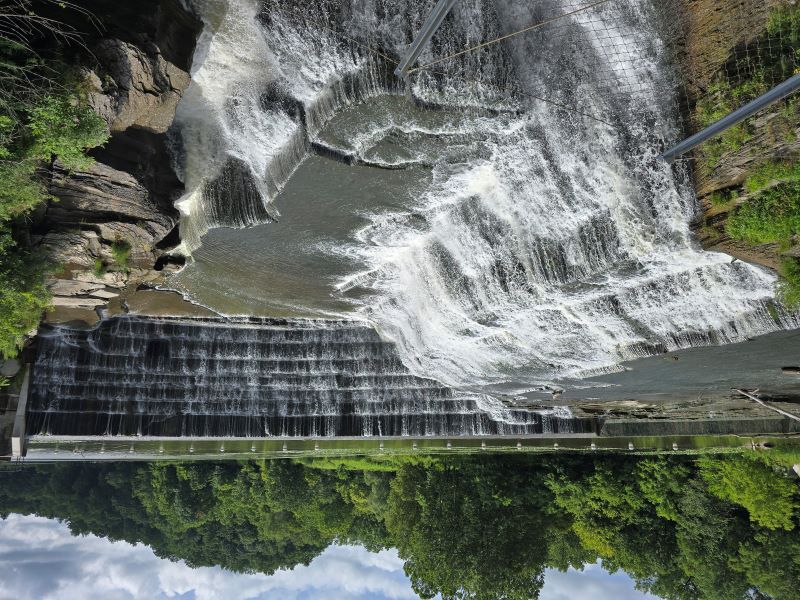
Triphammer Falls outside the Welcome Center. Can't compare to Niagara Falls we'd see later. Photographed from the bridge, with suicide prevention nets below. Why does this feel like Foxconn... Students, whatever situation you face, cherish life - human life is precious!
Ezra Cornell
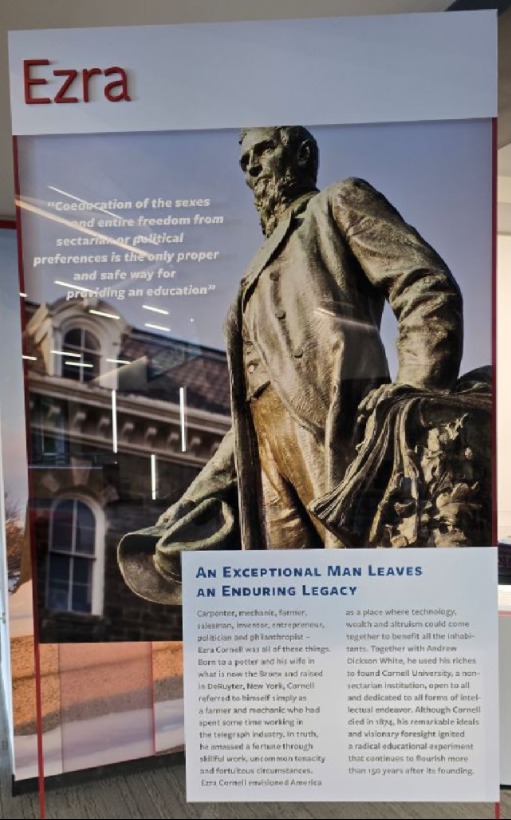
Ezra Cornell (Am I the only one who thinks Ezra looks like Lincoln in this picture?)
Ezra was born in New York City in 1807 and worked as a carpenter and mechanic in his early years. He later entered the telegraph industry, working as an assistant to Samuel Morse (yes, the Morse of Morse code). He eventually struck out on his own, building his business until he founded Western Union. You can imagine the telegraph industry then was like personal computers, mobile internet, and AI today - the cutting-edge technology creating wealth legends.
After making enough money, he could pursue philanthropic endeavors. Upon retiring from Western Union, Ezra first donated a library in Ithaca. In 1862, the Morrill Land-Grant Act was passed, allowing the use of federal land sales to establish land-grant universities. These universities were required to teach practical subjects like agriculture, mechanics, engineering, and military science2. This aligned perfectly with Ezra’s lifelong love of science and agriculture. He partnered with Andrew Dickson White to found Cornell University in 1865. Ezra died in 1874.
Two interesting facts: Cornell University’s charter grants Ezra’s direct descendants a lifetime seat on the board of trustees; from 1880-1882, his eldest son served as Governor of New York.
Andrew Dickson White
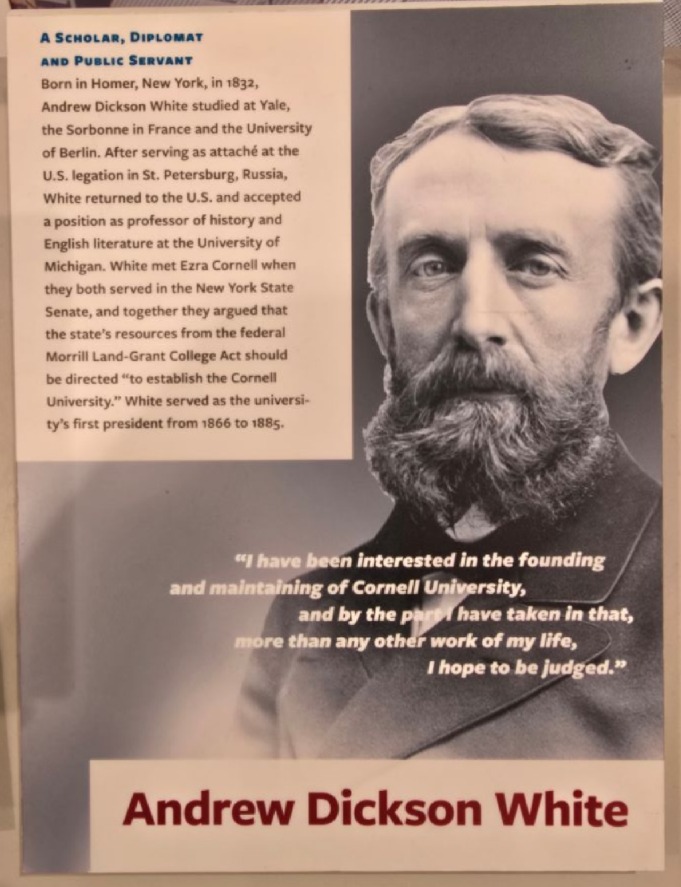
Andrew Dickson White
Andrew was born in 1832 and attended Yale University, where he was classmates with Daniel Coit Gilman, who would later become the president of UC Berkeley and the first president of Johns Hopkins University. After graduation, they traveled to Europe together. Andrew learned French and served as a translator for the US Ambassador to Russia3. Returning to America, he first taught at the University of Michigan. In 1863, he became a New York State Senator and met Ezra. The two hit it off on the idea of using the Morrill Land-Grant Act to establish a university. Andrew initially proposed locating the university in Syracuse’s transportation hub to attract faculty and students, but Ezra, who had been stiffed on wages as a carpenter in Syracuse in his youth (even tycoons started as workers!), insisted on placing the university in his hometown - Ithaca. Thus, Ezra provided money, land, and handled university construction and financial investment, while Andrew served as the first president, responsible for academic and administrative planning, recruiting faculty, and purchasing books and equipment. The first students enrolled in 1868, when he assumed the presidency, serving until his retirement in 1885.
In 1891, Andrew declined Stanford University founder’s invitation to become the first president of the newly established Stanford University, but recommended his student David Starr Jordan. Andrew later served as US Minister to Russia and Ambassador to Germany. He died in 1918.
Any person, any study
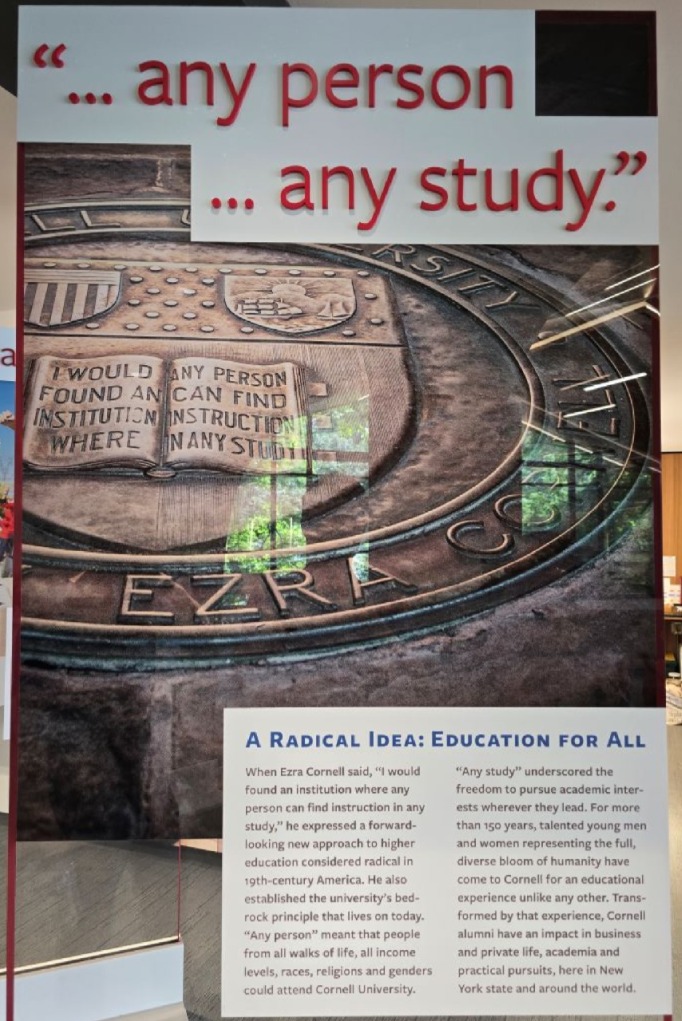
Any Person, Any Study
At the first opening ceremony, Ezra said, “I would found an institution where any person can find instruction in any study.” This statement, quite radical for its time, became Cornell University’s motto. Any person, regardless of occupation, race, wealth, gender, or religious belief; any study, whether traditional classical education or emerging practical subjects like agriculture, engineering, and mechanics (Cornell developed the first architecture and hotel management programs). What a magnificent declaration! Whether they could achieve it, and to what extent, was another matter, but at least they raised the banner and took a step in the right direction.
The Morrill Land-Grant Act
This land-grant act deserves more discussion. With the help of the land-grant act, a large number of land-grant universities were established across the United States, greatly advancing American higher education. Among land-grant universities are prestigious institutions including UC Berkeley, University of Illinois, Purdue University, Michigan State University, Rutgers University, Penn State, Texas A&M, University of Wisconsin-Madison, and MIT4.
The federal government granted land to these schools, but where did this land come from? The answer is it was acquired from Native American tribes through treaties, cessions, or confiscation. These schools were often built on Indigenous land, but another aspect is often overlooked: schools raised funds to build facilities and maintain operations by selling other Indigenous lands. This 2020 article reported in depth on this topic, calling these schools “land-grab universities.” Cornell, having benefited the most, became typical among these schools.
Land-grant universities were built not just on Indigenous land, but with Indigenous land.
In response, Cornell officially released a Land Acknowledgement in 2021:
Cornell University is located on the traditional homelands of the Gayogo̱hó:nǫɁ (the Cayuga Nation). The Gayogo̱hó:nǫɁ are members of the Hodinǫ̱hsǫ́:nih (Haudenosaunee) Confederacy, an alliance of six sovereign nations with a historic and contemporary presence on this land. The confederacy precedes the establishment of Cornell University, New York state and the United States of America. We acknowledge the painful history of Gayogo̱hó:nǫɁ dispossession, and honor the ongoing connection of Gayogo̱hó:nǫɁ people, past and present, to these lands and waters.
The school website has an even sharper critique:
Cornell’s founding was enabled in the course of a national genocide by the sale of almost one million acres of stolen Indian land under the Morrill Act of 1862. To date the university has neither officially acknowledged its complicity in this theft nor has it offered any form of restitution to the hundreds of Native communities impacted.
Ah, this part got a bit heavy. We Chinese are no strangers to this lesson - the backward get beaten. While excessive political correctness is annoying, I’m grateful to hear different voices here.
Distinguished Alumni
As an Ivy League school, Cornell has a long history with talented faculty and students. However, given my limited knowledge, I’ll just mention a few I recognized and some prominently displayed:
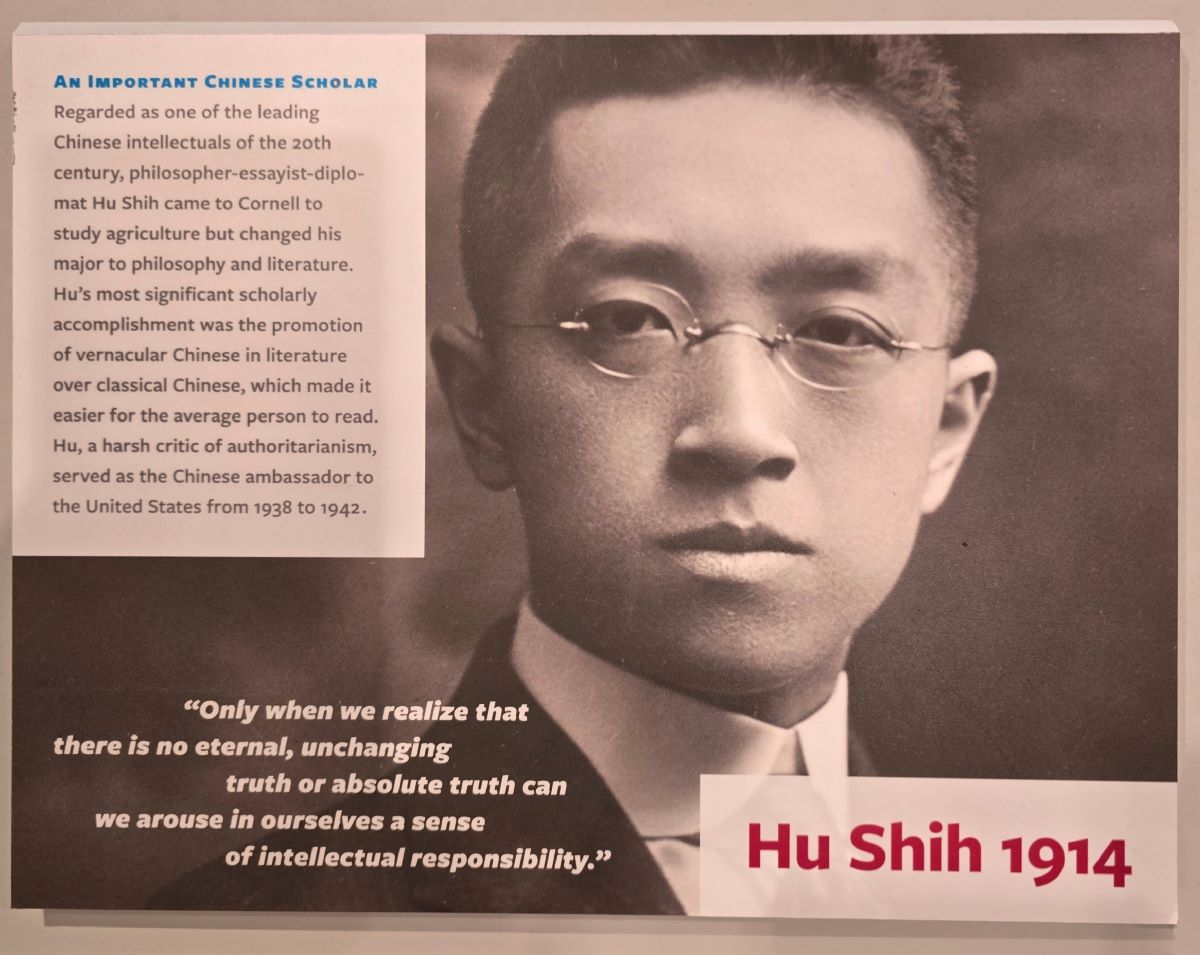
Hu Shih
Hu Shih, in 1910 received a Boxer Indemnity Scholarship to study agriculture at Cornell University. In 1911, inspired by the Xinhai Revolution, he abandoned agriculture for literature (Lu Xun: “I know this script”), switching to philosophy and literature. After graduating in 1914, he studied philosophy at Columbia University under John Dewey. He later promoted vernacular Chinese and served as Chinese Ambassador to the US from 1938-1942. He was also president of Peking University. I like his saying: “Fear not that truth is infinite; advancing an inch brings an inch of joy.” I also remember he often played cards in his diary, some entries written at Cornell, haha.
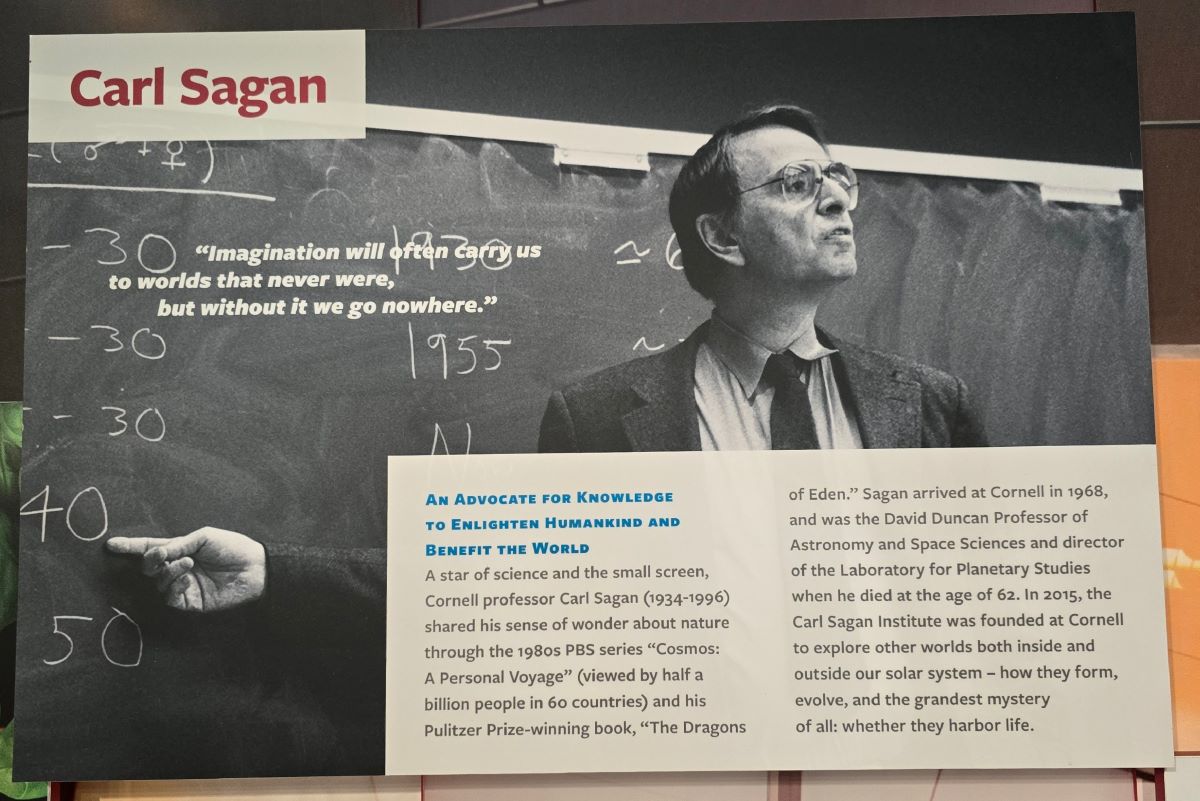
Carl Sagan
Carl Sagan, astronomer, but better known as what we’d now call a science influencer. He attended the University of Chicago at 16 (!), completing his bachelor’s, master’s, and PhD in one go. After teaching at Harvard and being denied tenure (!), he came to Cornell University in 1968, where he taught until his death in 1996. I love his Pale Blue Dot.
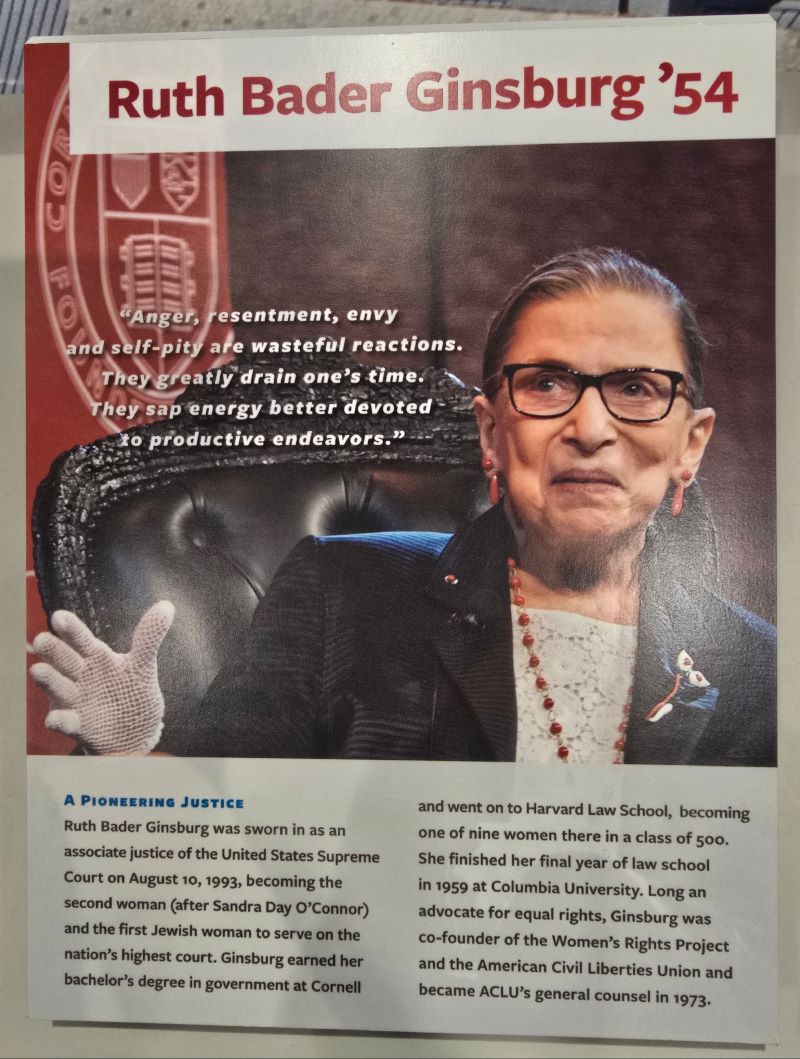
Justice Ginsburg
Justice Ruth Bader Ginsburg (RBG), Class of 1954 undergraduate. Appointed to the Supreme Court in 1993. In 2013-2014, she decided not to retire when Obama and the Democratic Senate could have appointed her successor. She died in September 2020, and 39 days later, Trump appointed the conservative Barrett as her successor.
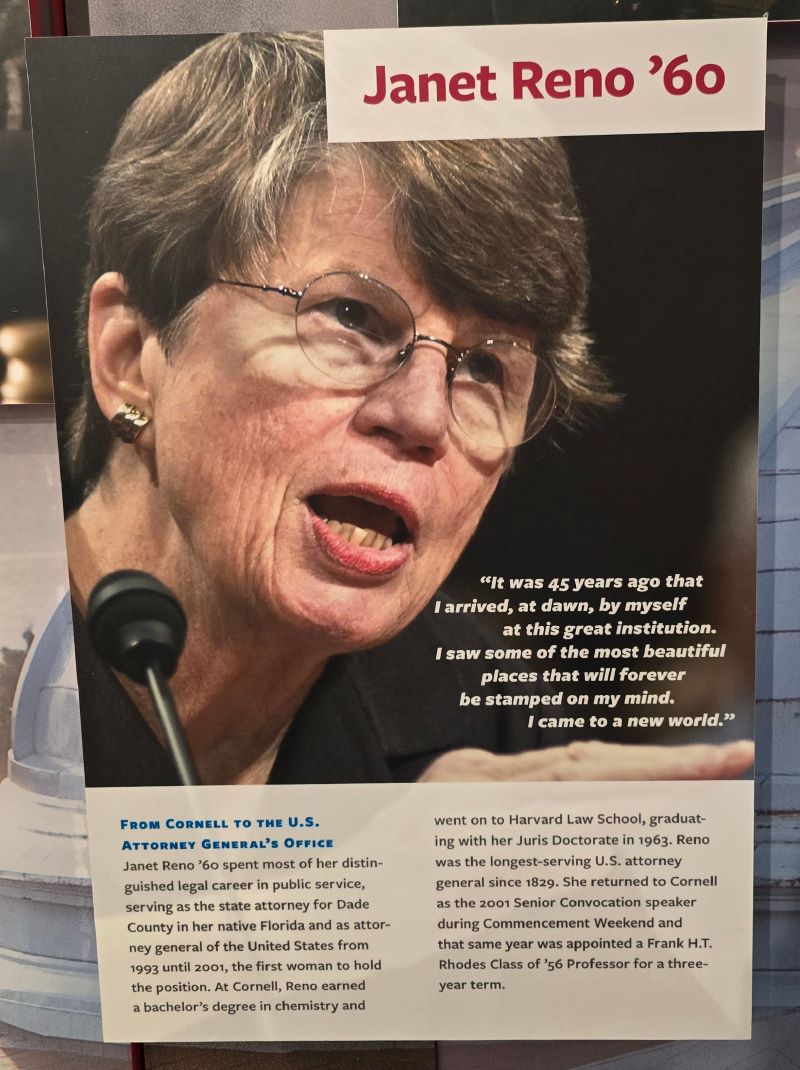
Janet Reno
Janet Reno, received a chemistry (!) degree from Cornell in 1960 and graduated from Harvard Law School in 1963. The first female US Attorney General (serving 1993-2001).
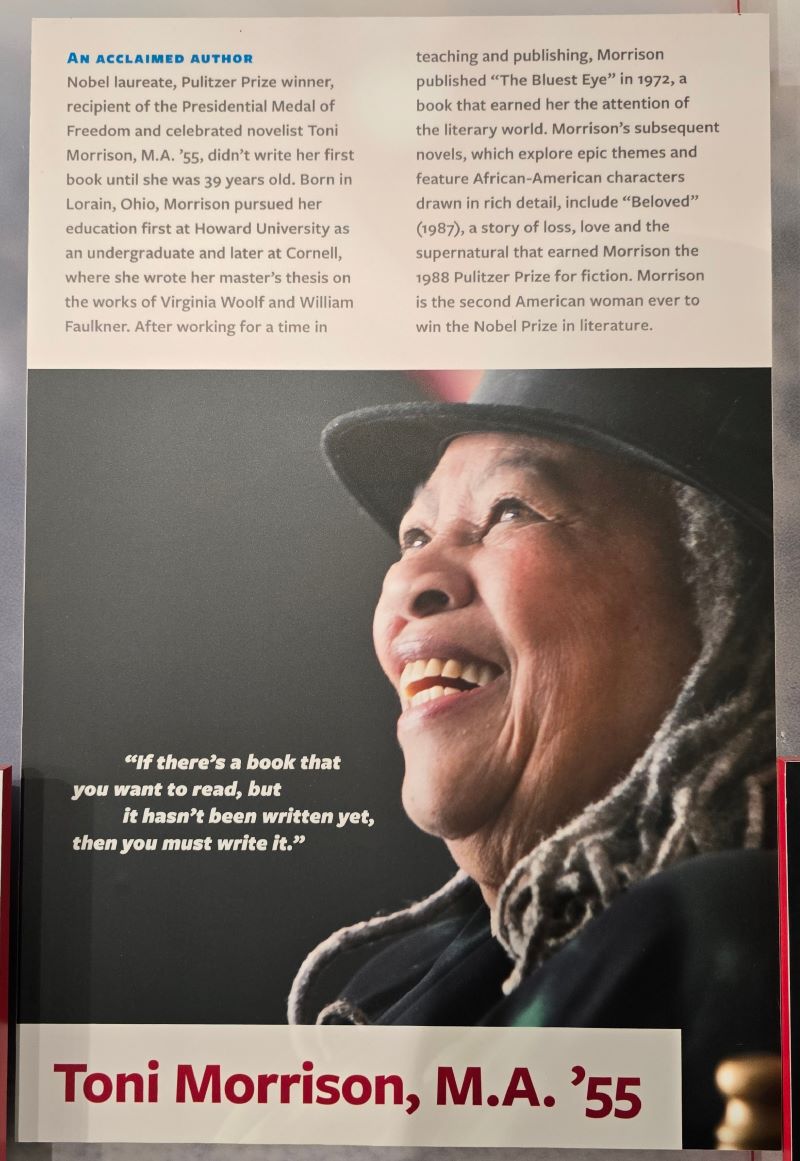
Toni Morrison
Toni Morrison, the first Black woman to win the Nobel Prize. American novelist who won the Pulitzer Prize in 1988 and Nobel Prize in Literature in 1993.
Nearby were also displayed many books written by Cornell faculty, students, and alumni. I learned that Bill Nye (who took Carl Sagan’s astronomy class!) and E. B. White (The Elements of Style) were also Cornell graduates.
Seeing these famous people’s familiar schools and majors, this is probably the difference between “I’m proud of XX” and “XX is proud of me” 😂
Campus Tour
Continuing with the official tour to visit the campus. Many buildings were under construction and maintenance during the summer, but I still took some photos. Let the pictures speak:
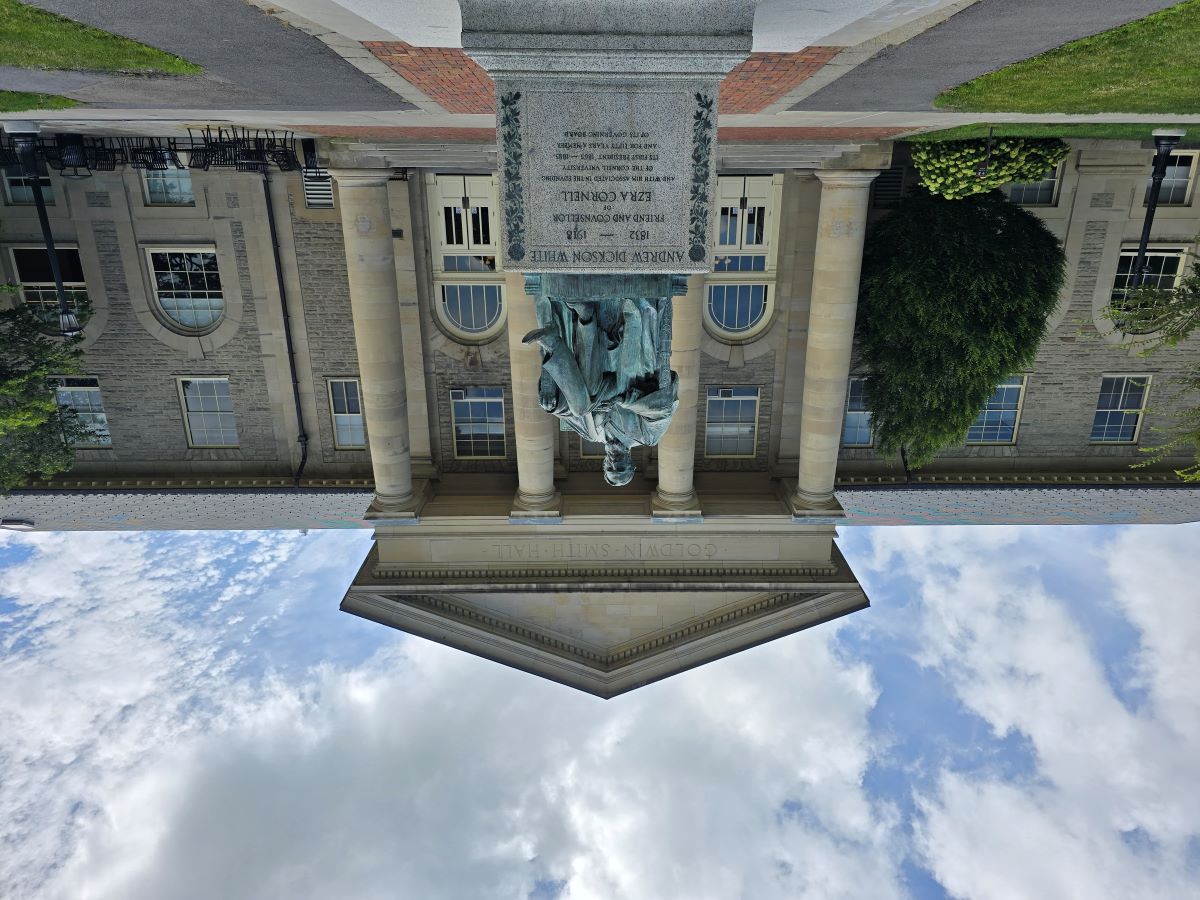
In the Arts Quad, statue of President Andrew in front of Goldwin Smith Hall
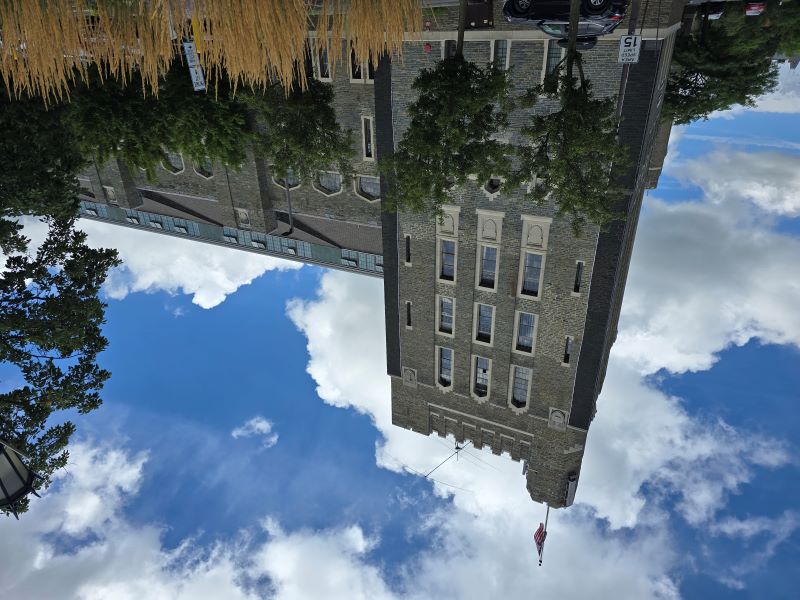
Fortress-like Barton Hall, housing the indoor track field and campus police.

The futuristic Bill and Melinda Gates Hall, completed in 2014, home to the College of Computing and Information Science. (They divorced, but the building name doesn't need changing, right? 😅)
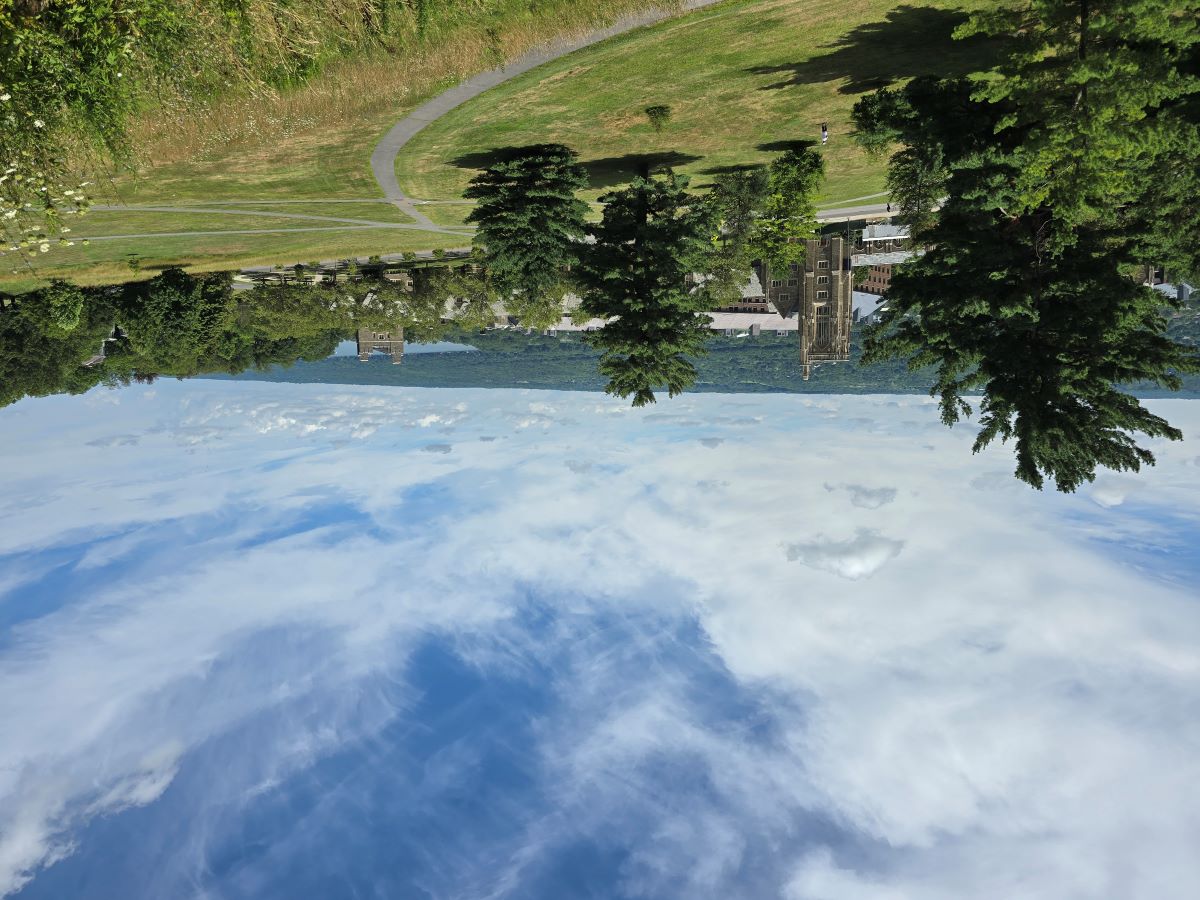
Libe Slope, overlooking West Campus and Ithaca, with Cayuga Lake to the right (north).
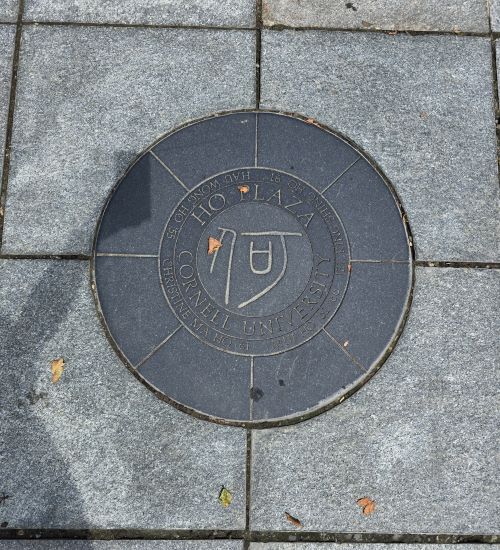
Ho Plaza, another Chinese-American benefactor! The nearby McGraw Tower is also a campus landmark.
Tour completed. To find out what happens next, stay tuned for the next installment!
-
The name Ithaca comes from Odysseus’s homeland in Homer’s epic. Many places in central New York are named after ancient Greek and Roman people and places (ref). ↩︎
-
Most universities established at that time only taught classical subjects like Latin, Greek, and mathematics. ↩︎
-
The Russian court and diplomacy used French at that time. ↩︎
-
Most land-grant universities are public, with few exceptions including Cornell University and MIT. ↩︎